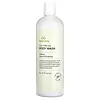What's inside
What's inside
 Key Ingredients
Key Ingredients

 Benefits
Benefits

 Concerns
Concerns

 Ingredients Side-by-side
Ingredients Side-by-side

Aloe Barbadensis Leaf Juice
Skin ConditioningGlycerin
HumectantSodium Cocoate
CleansingSodium Safflowerate
CleansingCyamopsis Tetragonoloba Gum
Emulsion StabilisingCamellia Sinensis Seed Oil
HumectantHelianthus Annuus Seed Oil
EmollientOryza Sativa Bran Oil
EmollientChamomilla Recutita Flower Extract
MaskingSalvia Officinalis Extract
AntimicrobialQuillaja Saponaria Wood Extract
Skin ConditioningCarica Papaya Fruit Extract
Skin ConditioningAnanas Sativus Fruit Extract
Skin ConditioningBambusa Arundinacea Stem Powder
AbrasiveTocopherol
AntioxidantCamellia Sinensis Leaf Extract
AntimicrobialGluconolactone
Skin ConditioningSodium Benzoate
MaskingPotassium Sorbate
PreservativeAloe Barbadensis Leaf Juice, Glycerin, Sodium Cocoate, Sodium Safflowerate, Cyamopsis Tetragonoloba Gum, Camellia Sinensis Seed Oil, Helianthus Annuus Seed Oil, Oryza Sativa Bran Oil, Chamomilla Recutita Flower Extract, Salvia Officinalis Extract, Quillaja Saponaria Wood Extract, Carica Papaya Fruit Extract, Ananas Sativus Fruit Extract, Bambusa Arundinacea Stem Powder, Tocopherol, Camellia Sinensis Leaf Extract, Gluconolactone, Sodium Benzoate, Potassium Sorbate
Alternatives
Ingredients Explained
These ingredients are found in both products.
Ingredients higher up in an ingredient list are typically present in a larger amount.
Glycerin is already naturally found in your skin. It helps moisturize and protect your skin.
A study from 2016 found glycerin to be more effective as a humectant than AHAs and hyaluronic acid.
As a humectant, it helps the skin stay hydrated by pulling moisture to your skin. The low molecular weight of glycerin allows it to pull moisture into the deeper layers of your skin.
Hydrated skin improves your skin barrier; Your skin barrier helps protect against irritants and bacteria.
Glycerin has also been found to have antimicrobial and antiviral properties. Due to these properties, glycerin is often used in wound and burn treatments.
In cosmetics, glycerin is usually derived from plants such as soybean or palm. However, it can also be sourced from animals, such as tallow or animal fat.
This ingredient is organic, colorless, odorless, and non-toxic.
Glycerin is the name for this ingredient in American English. British English uses Glycerol/Glycerine.
Learn more about Glycerin